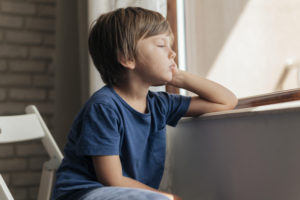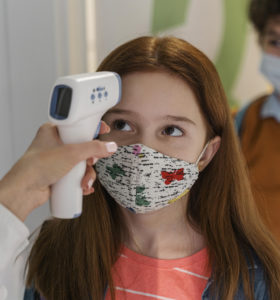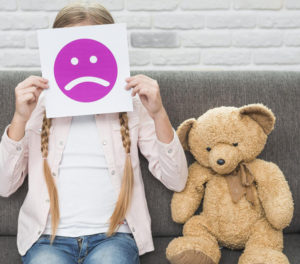The past year-and-a-half has weighed heavy in ways different on one and all. An invisible, mutating virus posed myriad visible challenges – from an overload of information and adapting to the “new normal” to adhering to newly-enforced norms of mask-wearing, restrictive and monitored movement.
What was thought to be a break from the “normal” for a week or two grew into a demon that was hard to avoid, forcing us to abstain from a social life.
“On some days when I feel sad, I talk to my mother. On others, I curl up in a corner and read a book,” adolescent Ashley Lyngdoh says.
 Does this sound familiar? Do we know many such Ashleys?
Does this sound familiar? Do we know many such Ashleys?
In the midst of the growing problems of rising COVID-19 positive cases, loss of life and slowing of economies, there also surfaced a much less talked about but equally significant aspect of life – mental and emotional well-being. Manifestations of grief, anger, stress, and anxiety over the cloud of uncertainty impacted not only the adults but also the adolescents and children. According to UNICEF, more than 330 million youngsters were stuck at home till March 2021 for at least nine months since the virus started spreading uncontrollably this time last year.
Confinement
With adherence to COVID protocols, the sudden shutdown of schools was a tough one to comprehend for most children. Constrained movement, staying indoors for most days marred spirits and made each passing day an arduous one to get by. Nayaab Suhel, a 14-year-old is happy to be spending quality time with her parents but sad to be away from her friends. “I miss playing outdoor games with my friends,” she says.
Shawn Thabah of Christian Academy School is frustrated about not being able to play his favourite sport, football. “I was in the Under-14 football team and would play at Mawkhar. Even though I exercise at home, I feel angry and helpless at the thought of not being able to do things that I love to do because of the lockdown,” he says.
The feelings of helplessness and lack of direction has been on the rise. “Over the last one year, children have experienced a sense of loss of missing family, big events such as birthdays,” affirms counsellorLorina Richmond. “There is also an increasing emotional burnout based on the frustration of staying at home. Children want to know when is this all going to end,” she adds.
 Disruptive normal life
Disruptive normal life
As the first measures of stay-at-home were announced, most assumed these were temporary with a few weeks off from offices and schools, thereby making it fairly hassle-free for most to cope with. As this ‘break’ stretched, disrupting the normal rhythm of life, real struggles became the norm. Things took a U-turn with online classes, increased gadget-handling, increased screen time and the onset of a sedentary lifestyle posing further complications. Nate Jyrwa (name changed) shares his despair: “The lockdown has changed me. I sleep late, wake late, not what I would normally do when I was going to school. I feel demotivated with online classes too as there are network issues. All I want to do is be on my own.”
Cynthia War, a teacher at Greenwood High, Bengaluru observes: “Children of late are feeling less fulfilled than previous generations as their accomplishments now are centred around academics. Children who otherwise excel in sports and cultural activities no longer have a platform to showcase this talent.”
While most students adapted, many suffered from the fall in the quality of learning. Pandemic or not, expectations from academic performance were high. Caellum Momin, a Class X student of Sherwood School, Tura, says: “Internet classes don’t make up for real classes even though teachers try their best. I do feel anxious at the thought of exams and my future.”
Remote learning and increased distractions at home affect the grasping of young students. Apart from that, exposure to the world of the Internet and the usage of devices and gadgets have also been a concern for parents from a perspective of increasing economic and financial burdens as well as the introduction to a world of online safety hazards.
Being socially distanced has led to a natural aversion in many to crowds and large amalgamations. “With the onset of the pandemic, there have been many children who have shown a sudden decline in academic performance, loss of interest in otherwise pleasurable activities complain frequently, may start staying aloof, get irritable and nervous easily, show disobedient, defiant or antisocial behaviour or tendency towards substance addiction too,” Chayanika Sarma, a psychiatrist says.
 What is to be done to be able to raise a generation with self-confidence, and find ways to tackle social withdrawal, needs to be analysed. Ashita Kar, a Class VII student, says: “I do miss my friends, playing with them, sharing a laugh or two during lunch hour. But now I’m a bit wary of crowds in general. I wouldn’t feel comfortable sharing space with 10 people in a room.”
What is to be done to be able to raise a generation with self-confidence, and find ways to tackle social withdrawal, needs to be analysed. Ashita Kar, a Class VII student, says: “I do miss my friends, playing with them, sharing a laugh or two during lunch hour. But now I’m a bit wary of crowds in general. I wouldn’t feel comfortable sharing space with 10 people in a room.”
A concerned parent echoes Ashita. “Children are using devices much more now – it is a boon in a way since they know so much more, but then the exposure is worrying. I would rather she met her friends and socialised,” she says.
Another worried parent states: “My wife and I can afford a device for my child, many other cannot. Radiation hazards because of online exposure and a disconnect from social engagement is not something I would encourage otherwise.”
Emotional needs of children
Much often when we refer to all school-going pupils under the umbrella term ‘children’, we undermine their age-specific needs and unknowingly relegate some to the background. It is critical to acknowledge that a primary school child, a pre-teen and a teen would have different emotional and physical needs, and would manifest them in different ways. In the words of counsellor Richmond of the Children’s Hospital, Shillong: “Child is a broad term, and children react differently depending on age, milestone status, emotional, physical and social development, language, as well as other factors such as socio-economic development.”
All these factors play a substantial role in a child’s mental make. “Pre-existing conditions such as panic, anxiety, these get worse with the ongoing pandemic,” she says.
Numerous factors interchangeably affect a child differently, sparking diverse reactions from all. It would be suitable to mention that differently-abled children have also been severely impacted by the COVID-induced lockdown. “The rise in technology has aided many children with special needs, especially those with hearing disabilities, but I do notice a decline in interaction as opposed to a face-to-face setting,” observers teacher War.
She shares an encouraging story on the use of technology. “I have had the experience of teaching a visually impaired child who used technology to their advantage. The software that we use in school allows for subtitles to appear on the screen as the teacher speaks, which I think is fantastic,” she says.
As a remedial measure to beat the stress and tantrums, Sarma says: “having a structured routine is important. The caregivers and families should be involved in their routine work so that they do not feel isolated.”
Growing Emphasis on Mental health
The long-drawn pandemic has exacerbated ongoing problems making mental and emotional well-being one of them. The National Mental Health Survey of India (2015-2016) had estimated that nearly 7.3% of Indian adolescents (13-17 years) suffer from mental health problems. As most of us are well versed with terms such as anxiety, stress, and depression, these are often resultant qualities of greater underlying causal factors, heightened all the more with the pandemic. “Fear of getting the virus, especially if a close member of the family or friend has contracted the virus, rising deaths result in trauma, anxiety, and even suicidal thoughts have been on the rise,” Richmond says.
The long and unending pandemic has ushered in uncertainty and stress, which have increased the emotional needs of not only adults but children too. “The emotional needs in children are manifested by emotional and behavioural symptoms has been rising. For example, a child between 1 and 3 years of age who is usually influenced by parental behaviour may become uncooperative and on separation from mother or caregiver may show signs of anxiety such as crying spells and restlessness,” Sarma says.
No longer a taboo
Since times immemorial, mental health has earned a reputation associated with negativity and subjected to ridicule. Yet, psychiatrists sense a rise in acute stress reaction and post-traumatic symptoms even among people with no history of mental illness. According to experts, the pervasive coronavirus has been impacting the economy as well as leaving psychological scars.
“Some of my friends have been sadder because of the pandemic. They just sit in a corner and have nobody to talk to. They don’t feel comfortable talking about their feelings because of the fear of being judged and made fun of,” Momin says.
Sarma elucidates, “Mental illnesses are diseases of the brain just as any part of the body and is not a sign of a weak mind or mental instability. Mental illnesses are curable. Awareness is very much necessary to eradicate the various myths and stigmas prevalent about mental illness, which forbids a person from seeking help or discussing them.”
Creating a congenial environment and support system is thus crucial. “Owing to the rising accessibility, I do receive a huge number of tele-counselling requests, and I do think there is a need for mental first aid just like medical first aids,” Richmond says.
Almost all students interviewed were asked if they would feel more at ease if vaccination for COVID-19 were to be made available for them and their age groups. The answer was an emphatic yes. “If I get vaccinated, everyone around me and I will be safer,” Ashita says. “I would be relieved to an extent. Our teachers are getting vaccinated, so if we students get jabbed too, classes can resume in full swing like old times,” Caellum says, underlining why at all levels including administrative, efforts need to be made to ensure a thriving future of this young generation.
Generating an amicable ecosystem in the immediate surroundings of children across age groups can go a long way in treating and addressing such issues. As the world grapples with a larger problem of fighting a deadly disease by following health protocols, mental well-being also entails its own set of dos and don’ts within homes and within the larger ambit of wellness. While watching out for early signs related to mental health, can be a starting point for coping mechanisms, others can also include cultivation of healthy habits and relationships, identifying a trusted mentor within one’s surroundings and encouraging seeking professional help.
Lending an ear once in a while mixed with some compassion can be a recipe for happiness for many. Esha Chaudhuri




 Disruptive normal life
Disruptive normal life